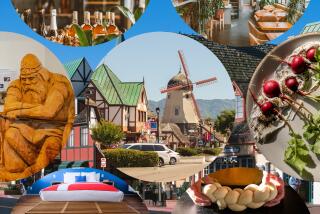Learning of a Danish Ancestor’s Travels
- Share via
Question: My ancestor, Niels Larsen, came to America from Odense, Denmark in 1872. How can I learn what ship he came on and how he traveled to Howard County, Neb.?
Answer: Unfortunately, National Archives has no index for New York passenger lists for 1847-96 and that is probably the port through which your ancestor came. To search these records is an enormous task as they are listed chronologically. The archives will not do it unless you know the name of the vessel and approximate date of arrival.
The LDS (Mormon) Genealogical Library in Salt Lake City has emigrant lists (1868-1911) from Denmark with an alphabetical index by the year. These films are available to all LDS branch libraries.
Your ancestor may appear on Danish emigrant lists that were compiled by the Copenhagen police between 1868 and the 1930s. These microfilmed lists, in chronological order, give name of the emigrant, age, address, place of birth, occupation, destination and in some cases, the name of the ship. Write to Landsarkivet for Sjaelland, Jagtvej 10, 2200 Kobenhavn N. Be sure to send three international reply coupons with your inquiry.
In Denmark during the 1870s, agents promoted emigration. Many were hired by railroad, steamship and land companies. Danish emigrants often traveled on tickets prepaid from the United States, and since your ancestor came during this time, indications are he probably went by rail to Nebraska.
Consult “Life in an American Denmark” by Alfred C. Neilsen. It is a small county history about Howard County, Neb. The State Historical Library, 1500 R St., Lincoln, Neb. 68508, has a copy of it.
Q: My ancestor, Anthony McConaha/MacConaghy, supposedly was “spirited” from Glasgow, Scotland at age 7 and served on a ship until he was 21. I have located him in Ohio County, Va., in 1799 and want to continue the research in Scottish records. How can I do this?
A: With such a common name--a branch of the Scottish clan Robertson found in Scotland and Ireland--research is going to be difficult. If he was spirited, he may have been an orphan and you may not be able to extend this line.
If you can determine the name of the ship he served on and whether he was a merchant seaman or in the Royal Navy, consult the chapters on naval ancestors in Gerald Hamilton-Edwards’ book, “In Search of British Ancestry” ($26.25 postpaid from Genealogical Publishing Co., 1001 N. Calvert St., Baltimore, Md. 21202).
Q: I contacted Family Tree--a source you recommended--regarding my English ancestors in the old country but have had no response.
I am looking for Crimp, Beers and Friend ancestors. How can I correspond with family groups in England?
A: Family Tree is a bimonthly magazine. It is an excellent source to place queries pertaining to your English families as it circulates in Great Britain, United States, Canada and Australia.
International Society for British Genealogy and Family History (ISBGFH), Box 20425, Cleveland, Ohio 44120 ($10 annual membership dues) publishes a newsletter and can provide you with names and addresses of the Federation of Family History (genealogical) Societies in England.
Contact Cornwall Family History Society, for example, and inquire about others researching your surnames there. Ask about one-name societies also. You may discover English cousins working on your lines who will be delighted to hear from you.
While neither the magazine or ISBGFH does personal research, both print timely information pertaining to one-name and family history societies in England.
More to Read
Sign up for Essential California
The most important California stories and recommendations in your inbox every morning.
You may occasionally receive promotional content from the Los Angeles Times.












